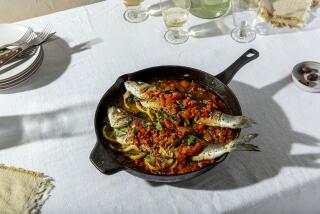Red Meat Important in Women’s Diets : Disdained Beef a Factor in Iron Absorption, Study Shows
- Share via
I have recently sensed an interesting conflict in people’s attitudes toward red meat. Some proudly boast that they never eat meat anymore. Others defiantly proclaim they will never give it up. And those in the middle struggle to do without, but sometimes succumb to the seduction of a big, juicy burger or a tender filet.
Should you give up red meat? The answer may be different for men and women.
If you are a woman in childbearing years, consider carefully before deciding to go cold turkey.
As usual, national recommendations for people of all ages to reduce fat and cholesterol intake are based on statistics collected from men. But premenopausal females have a very low risk of heart disease, believed to be due to a protective factor related to their hormonal system.
Three Groups of Women Studied
Furthermore, a study done in Seattle showed that low blood cholesterol levels during the reproductive years are not diet-related. That study compared three groups of women: those who ate red meat at least five times per week, those who used fish and poultry as their main protein source and those who used only lacto-ovo-vegetarian (milk and eggs) sources of protein.
Despite the fact that the red-meat group ate considerably more cholesterol and saturated fat, their total blood cholesterol, LDL (bad) cholesterol, HDL (good) cholesterol and triglycerides were the same as in the other groups.
The difference was their iron status. Despite the fact that dietary iron intake was similar for all groups, the red-meat group had higher blood levels of iron. Low iron levels among the other two groups placed them at higher risk of iron-deficiency anemia (that’s right: “iron-poor blood,” a common problem among women in mid-life).
Red meat seems to contain a factor that improves the absorption of iron from the meat, as well as from other foods eaten at the same time, such as bread, cereal, grains, beans and vegetables.
So mid-life women are at low risk for heart disease, but high risk for iron-deficiency anemia. This means that moderate amounts of lean red meat could be a real nutritional bargain for this group.
Other Points to Consider
But there are other points to consider. High-fat diets increase the risk of cancer, regardless of age. And fat is high in calories. Eating fat makes you fat. Then menopause wipes out the protective hormones, rapidly increasing the risk of heart disease. So lifelong good habits remain important.
What’s a woman to do?
Choose the leanest cuts of beef. Lean, trimmed top round contains only 6 saturated-fat calories per ounce compared to 12 for sirloin, 17 for chuck or rib roast, or 25 for lean ground beef.
If you cannot resist an occasional hamburger, try mixing ground beef with ground turkey to cut saturated fat in half.
Watch out for other sources of fat. Many women trade iron-rich meat for high-fat foods of lower nutritional value.
Three ounces of top round (18 saturated-fat calories) on two slices of whole-wheat bread (8 saturated-fat calories) equal 26 saturated-fat calories plus the “meat factor.” Three ounces of white-meat turkey (3 saturated-fat calories) on a croissant (32 saturated-fat calories) for a total of 35 saturated fat-calories is not as benign as it first appears.
More to Read
Eat your way across L.A.
Get our weekly Tasting Notes newsletter for reviews, news and more.
You may occasionally receive promotional content from the Los Angeles Times.









